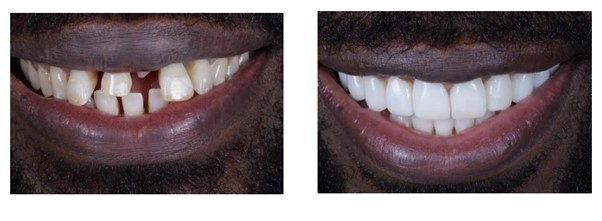A 43-year-old patient originally came to the clinic seeking healthy, straight teeth. His main concern was the significant spacing between his teeth, especially in the maxillary labial segment. At the time of his first appointment, he was wearing a gold, windowed bridge, but he hoped to correct the spacing with a combination of clear aligner treatment and composite or porcelain veneers.
His initial full case assessment included clinical photographs, full dental radiographic and periodontal examinations and a digital intraoral 3D scan using an iTero scanner. A photograph for Invisalign Smile Architect was also taken using the Invisalign Practice App and was used to help understand the patient’s existing dental concerns and his desired end goal.
The assessment revealed generalised spacing, underlying gingival health issues (BPE scores of 3 in 3 sextants) and failed existing amalgam restorations. The detailed information was used to review the records and discuss the importance of stabilising and improving his gingival health before beginning orthodontic treatment.

Treatment planning
Our treatment plan included Invisalign clear aligners to redistribute his dentition spacing more evenly and correct his splayed teeth in advance of placing the composite veneers. We created a ClinCheck digital treatment plan using Invisalign Smile Architect, which enabled the patient to visualise how his teeth would move and how the space distribution would be achieved before his final cosmetic restorations.
The patient’s treatment plan comprised:
- A complex hygiene appointment with at-home oral hygiene and toothbrushing instructions, followed by root surface debridement eight weeks later.
- A dental health review three months later, alongside removal of the bridge to his UR12 and a final iTero intraoral scan to assess soft tissue position, merged with his ClinCheck treatment plan.
- Eight months of Invisalign treatment consisting of 19 initial active clear aligners.
- Aligners one and two worn for two weeks each with no attachments to allow for compliance and let the patient acclimatise to his treatment. Attachments were placed on aligner three.
- Refinements comprised 10 upper, active, two passive and three overcorrection aligners: 12 lower active aligners and three overcorrection aligners.
The patient was fully compliant throughout his treatment. The visualisation provided a strong motivation for both the patient and the clinicians involved in the case and contributed to adhering to the wear time instructions.

A smile makeover
As treatment neared completion, we conducted a final assessment and used the Invisalign Smile Architect software to create a digital smile design and trial smile using the Smile Creator module within the exocad platform. Our lab team uses the DentalCAD software with all our digital cases utilising iTero scans and Smile Creator to merge the two together as part of the digital workflow.

Review
Patient feedback was incredibly positive. Being able to visualise both the orthodontic outcome alongside the restorative enhancements gave him both confidence in his treatment plan and a commitment to adhere to instructions to help achieve his smile makeover.
Leveraging a single ecosystem to combine Invisalign treatment with restorative planning using Invisalign Smile Architect allowed us to improve patient-centred care and achieve a successful smile transformation.

For more information visit https://www.invisalign.co.uk/gp/invisalign-solutions/smilearchitect

